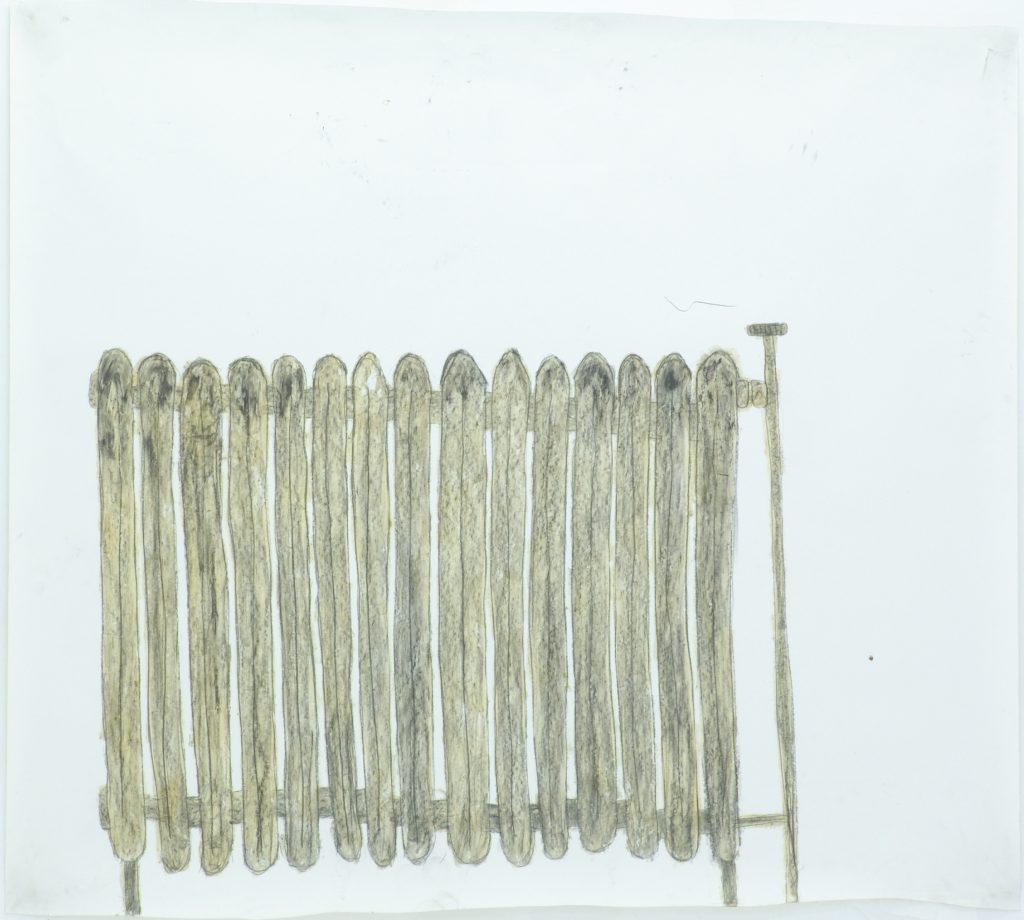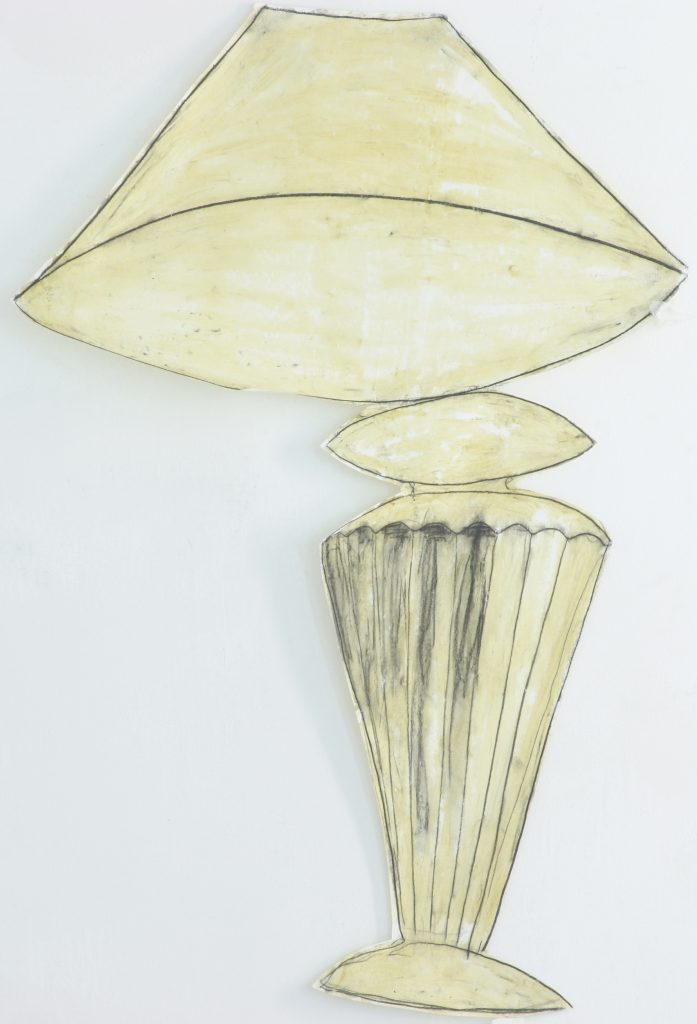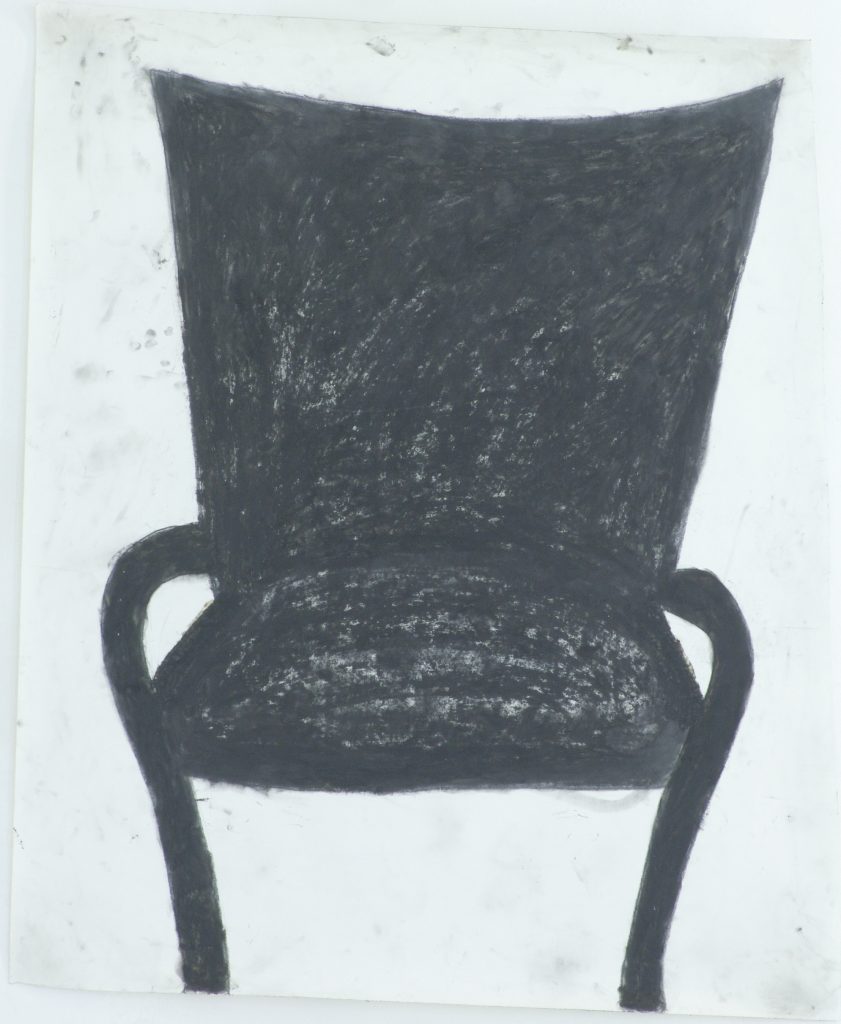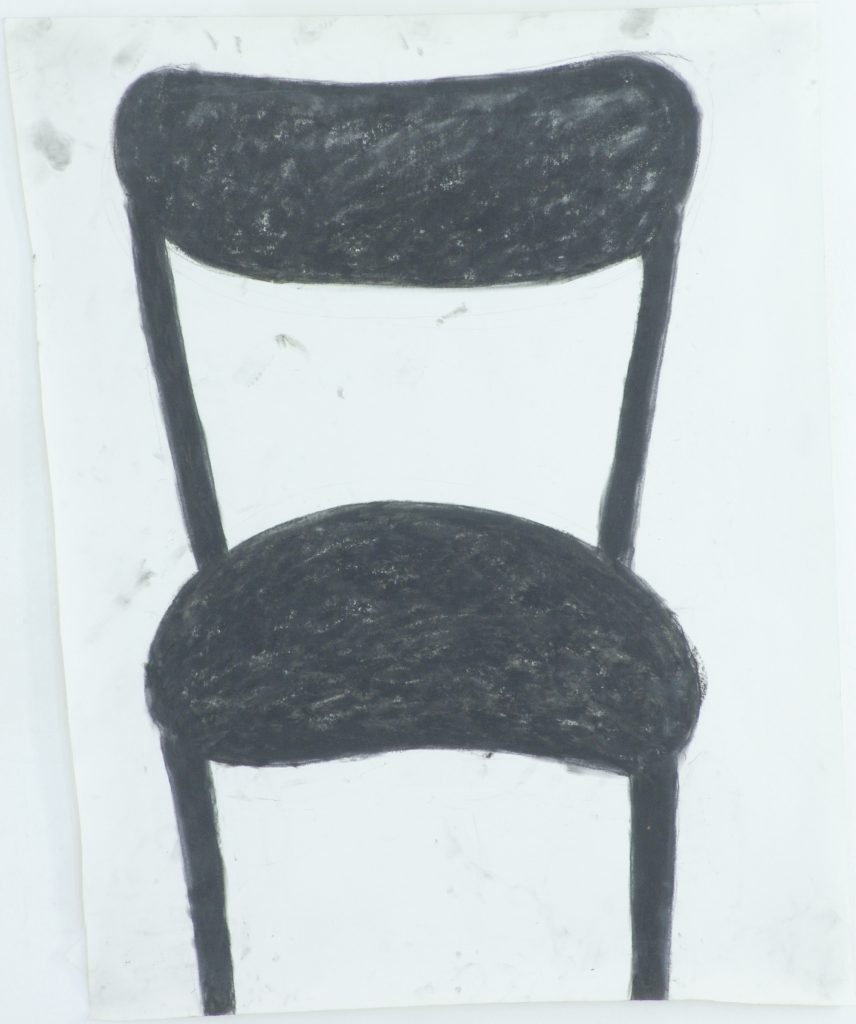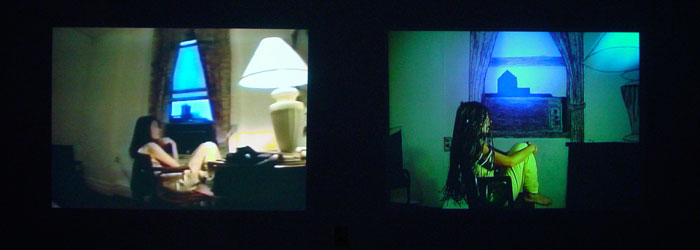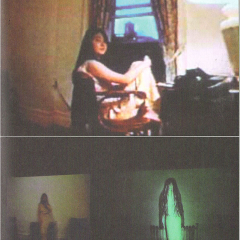New York 2003
The TALE OF GENJI is a novel written by lady MURASAKI SHIKIBU in the early 11th century describing the court life of Heian JAPAN – the most peaceful period in Japanese history that lasted from 794 to 1185 . It depicts the life and times of the beautiful prince Genji, who devotes himself to nothing but pleasure. At some point very bored he discovers stunningly beautiful girl with thick and lustrous black hair and he is enchanted by her character. Driven by desire he steals her and brings her to his premises in the royal court. There he educates her to become a ‘perfect woman’…
I met YUKIKA KUDO (her name in translation is „the scent of snow“) at the CHELSEA HOTEL NYC in 1994. On our initial day i did an interview with her in her hotel room, which is the basis to the video from 2003. That year I went to NYC again, reconstructed the room of the Chelsea by means of a drawings and made a paper wig resembling Yukika’s hair. I asked three women (Austrian, American, Japanese) to put on the wig, slip into Yukika’s role, sit down in the same position as Yukika in the drawn Chelsea room and quote what she had said back then a re-enactment. Actually until this day – 2024 – 30 years later we are still bound to each other in loving care and as permenent partners in crimes.
In a show at Vienna’s Charim Galerie 2003 the video of Yukika in the real Chelsea and the video of the replica Yukika’s in the drawn Chelsea room were then juxtaposed – so that the replica Yukikas would answer the original in a time warp.
THE SCENT OF SNOW is an INSTALLATION for art venues. It consists of drawn two-dimensional sets, five movies and a wig that was made out of paper and graphite for the protagonists in collaboration with Kazuko Miyamoto. It is the second chapter in combining drawn sets and actors and thereby questioning the concept of central perspective/3D. The other chapters being ENDURING FREEDOM 2001, TARZAN 2011, LONGING 2012 and its climax the feature film LOS FELIZ 2016.
16 minx2 / 3 min x 2, dual screen
New York / Vienna 1994/2003
texts by Yukika Kudo
actors Elisabeth Gottfried, Yuka Miyanagi, Valerie Shields
camera, set design Edgar Honetschläger
editor Thomas Woschitz
line producer Yoshiji Nishimoto
organizer Kazuko Miyamoto
first shown at Charim Gallery Vienna
DER GERUCH DES SCHNEES (scroll for english below)
Im 11. Jahrhundert schrieb die japanische Hofdame Murasaki Shikibu den Roman GENJI MONOGATARI (die Geschichte des Prinzen Genji). Sie beschreibt darin das Leben eines jungen Prinzen, der sich nur um sein eigenes und das Wohl aller Hofdamen kümmert, die er beglücken kann. An einem bestimmten Punkt seines Genusslebens stiehlt er ein junges Mädchen und lässt sie zur idealen Frau erziehen, da keine andere Frau seinen Ansprüchen genügen will.
Diesen Roman interpretiert Edgar Honetschläger als Teil verallgemeinerbarer Erfahrungen und wählt ihn zum Ausgangspunkt für seine Ausstellung in der Charim Galerie. Der Titel „Der Geruch des Schnees“ dient ihm dabei als poetische Metapher, die zunächst an die Schneeluft denken lässt, mit der sich der Winter nach nebelnassen Novembertagen ankündigt. Er ist aber auch der Name einer jungen Japanerin, Yukika, die Edgar Honetschläger Mitte der 90er Jahre in New York kennen lernte. Von dieser ersten Begegnung in einem Zimmer des Chelsea Hotels NY existiert ein Video und in den folgenden Jahren wurde Yukika zu einer der Hauptdarstellerinnen in allen seinen Filmen.
An dieser Geschichte, die auch die Geschichte einer Liebe ist, scheint kaum etwas Ungewöhnliches zu sein, sieht man von der poetisierenden Kraft der Liebe ab, die in zahlreichen E-Mails ihr zeitgemäßes Medium gefunden hat, und denen in der Ausstellung eine wesentliche Rolle zukommt. Nichts Ungewöhnliches, wie gesagt, wären da nicht Honetschlägers Filmschaffen und das Kino. Im konkreten Fall der Ausstellung vergegenwärtigt Edgar Honetschläger mit den Mitteln des Films eine vergangene Szene, die erste Begegnung mit Yukika im Chelsea Hotel NY. Auch dies wäre kaum ungewöhnlich, wäre da nicht die Kunst.
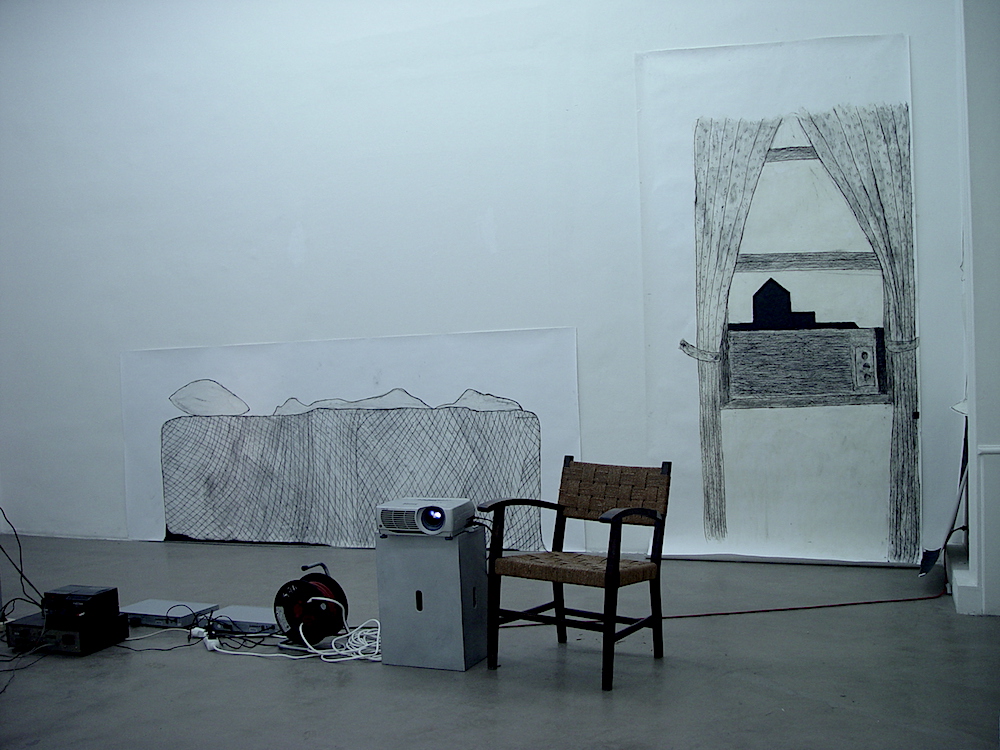

Im Bereich der bildenden Kunst hat sich ein eigenes Genre herausgebildet, das unmittelbar auf den Film als Material und das Filmische als konzeptuellen Hintergrund aufbaut. Das Kino wird dabei vielfach als Apparat inszeniert, in dem Projektion, Bildwirkung, imaginärer und realer Raum, als einzelne Teile erfahrbar werden sollen. Edgar Honetschläger beschreitet in seiner künstlerischen Arbeit einen anderen Weg indem er das „Szenische“ des Films und die Inszenierung in den Vordergrund rückt. Die Ausstellung selbst lässt sich deshalb auch als verräumlichter Film deuten, in der die BesucherInnen eine „Szene“ als Ort jenes Geschehens betreten, das mit den Quellen der filmschaffenden Imaginationen Honetschlägers verbunden ist.
Die Geschichte des Prinzen Genji fügt eine weitere Dimension, die der Inszenierung, hinzu. Nicht nur die in Szene gesetzte und re – inszenierte Vergangenheit, auch die Tätigkeit des Regisseurs gerät dadurch ins Blickfeld. Seine Arbeit wird als gestaltender Prozess sichtbar, der bis in die kleinsten Gesten der Mimik und das Aussehen der Darstellerinnen hineinreicht. Die bildhaften Leitmotive der Filme von Edgar Honetschläger sind deshalb ebenfalls ausgestellt. Es handelt sich dabei durchwegs um Portraits von Yukika, die in verschiedenen Rollen zu sehen ist. So etwa in einem Doppelportrait, das an ihre erotische Präsenz als Verführerin und den Charme eines scheuen Schulmädchens denken lässt (Milk, 1997).
Die Zeitlinie aus der Vergangenheit in die Gegenwart führt durch alle diese Frauen-Bilder hindurch, um schließlich in eine kritische Selbstbefragung zu münden. Edgar Honetschläger inszeniert auch diese als „Film“ in dem er existentielle Erfahrungen als Reflexionsanreiz über das Medium Film/Kino nutzt. Seine künstlerische Arbeit wird dadurch zum Darstellungsfeld des Filmischen, der Reflexion über das Kino mit den Mitteln der Kunst.
KURT KLADLER
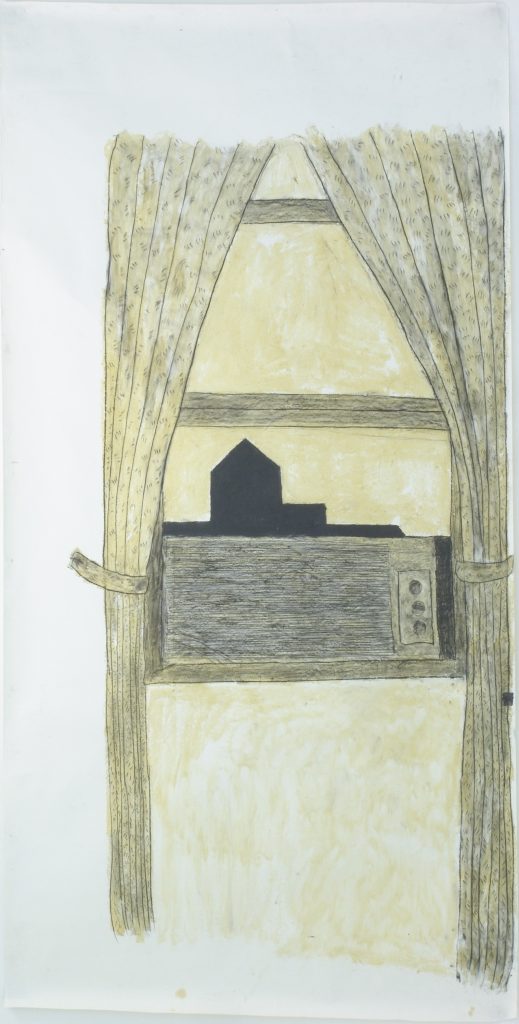
THE SCENT OF SNOW
In the 11th century, the Japanese lady-in-waiting Murasaki Shikibu wrote the novel GENJI MONOGATARI (the story of Prince Genji). In it, she describes the life of a young prince who is concerned only with his own well-being and that of all the court ladies he can please. At a certain point in his life of pleasure, he steals a young girl and has her brought up to be the ideal wife, as no other woman will satisfy his demands.
Edgar Honetschläger interprets this novel as part of generalizable experiences and chooses it as the starting point of an exhibition. The title “The Scent of Snow” serves him as a poetic metaphor that initially brings to mind the snowy air that heralds winter after foggy November days. But it is also the name of a young Japanese woman, Yukika, whom Edgar Honetschläger met in New York in the mid-1990s. There is a video of this first encounter in a room at the Chelsea Hotel NY and in the following years Yukika became one of the leading actresses in all his films.
There hardly seems to be anything unusual about this story, which is also the story of a love affair, apart from the poeticizing power of love, which has found its contemporary medium in numerous e-mails and which play an essential role in the exhibition. Nothing unusual, as I said, were it not for Honetschläger’s film work and the cinema. In the specific case of the exhibition, Edgar Honetschläger uses the means of film to visualize a past scene, the first encounter with Yukika in the Chelsea Hotel NY. This too would hardly be unusual were it not for the art if he did not and re-enact and stage the scene with the help of three actresses-
In the field of visual art, a separate genre has emerged that builds directly on film as material and the cinematic as a conceptual background. Cinema is often staged as an apparatus in which projection, image effect, imaginary and real space are to be experienced as individual parts. Edgar Honetschläger takes a different approach in his artistic work by focusing on the “scenic” aspect of the film and its staging. The exhibition itself can therefore also be interpreted as a spatialized film, in which visitors enter a “scene” as the location of events that are linked to the sources of Honetschläger’s filmmaking imagination.
The SCENT OF SNOW adds another dimension to the story of Prince Genji , that of staging. Not only the staged and re-staged past, but also the director’s work comes into focus. His work becomes visible as a creative process that extends to the smallest gestures of facial expression and the appearance of the actresses. The pictorial leitmotifs of Edgar Honetschläger’s films are therefore also exhibited. These are all portraits of Yukika, who can be seen in various roles. For example, in a double portrait that brings to mind her erotic presence as a seductress and the charm of a shy schoolgirl (Milk, 1997).
The timeline from the past to the present leads through all these images of women, ultimately culminating in a critical self-questioning. Edgar Honetschläger also stages this as a “film” in which he uses existential experiences as an incentive to reflect on the medium of film/cinema. His artistic work thus becomes a field of representation of the cinematic, of reflection on cinema with the means of art.
KURT KLADLER
